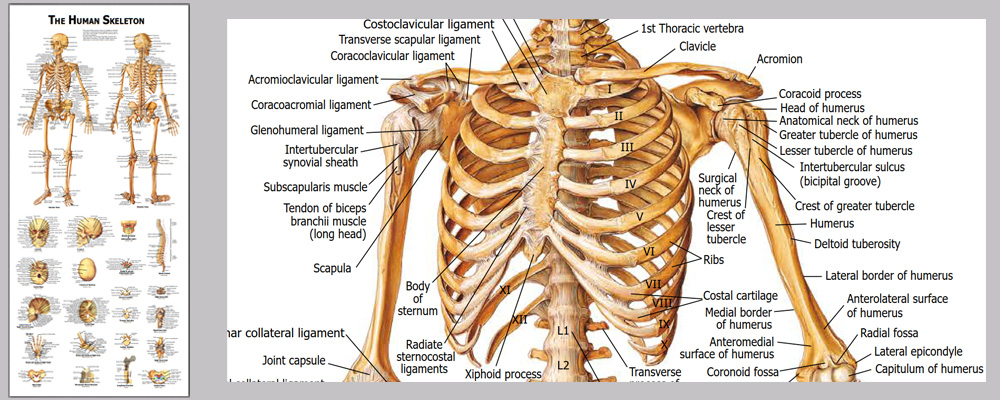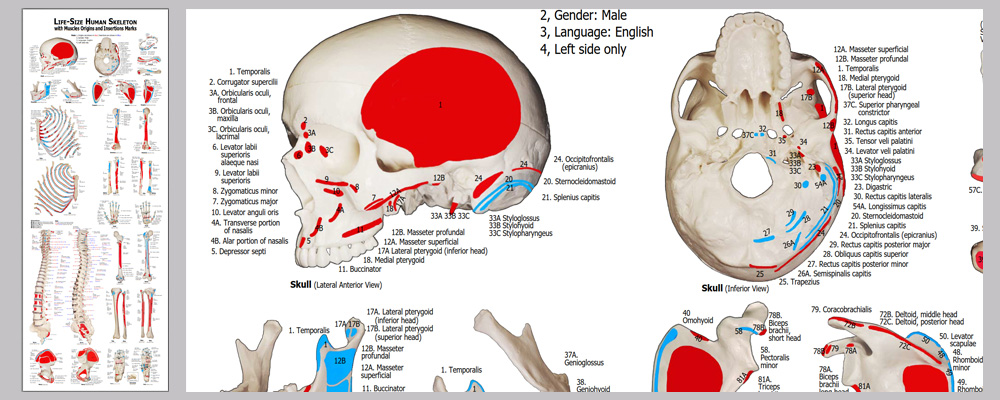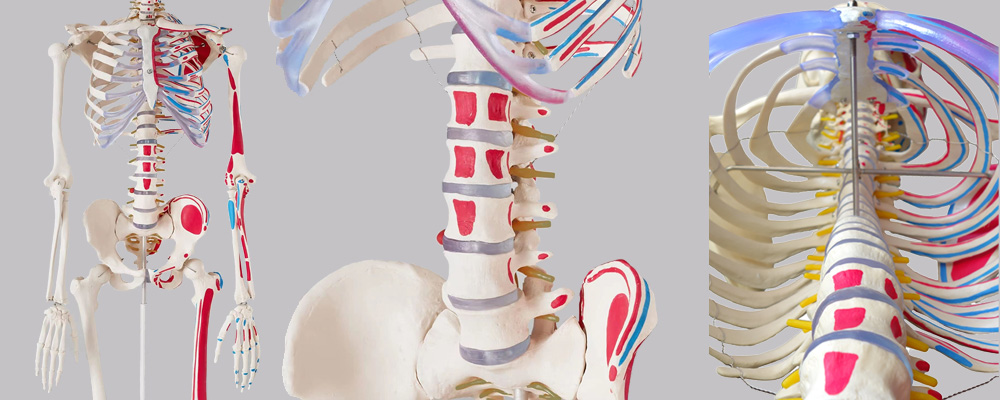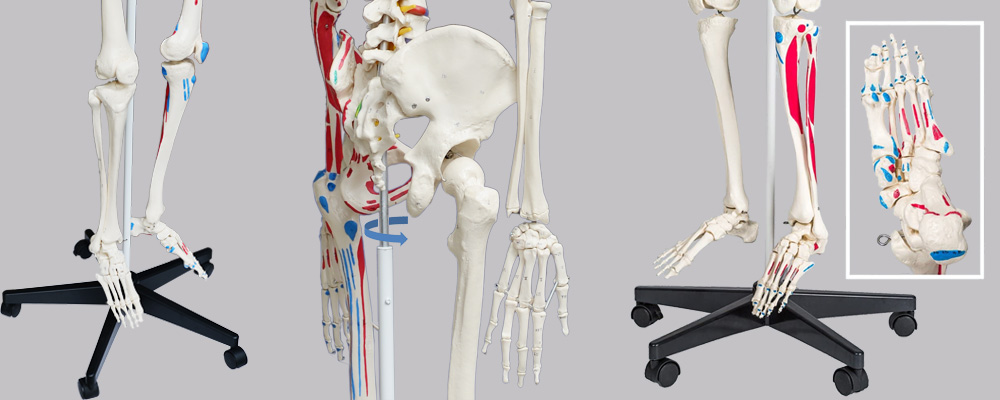labelled human skeleton model
This life size articulated adult human skeleton model is 180cm tall & ideal for teaching / learning the basics of human anatomy. Includes a colorful Human Skeleton chart to show all the detailed structures for reference.Detailed colorful chart with over 630 accurate definitions. Durable and no reflection with matte film covered, 36 * 78cm

Detailed muscles origins and insertions with codes. Durable and no reflection with matte film covered, 100cm * 38cm

Stainless steel wires keep the ribs gaps stable.

2 of 5 casters are lockable.

With JC anatomy, you can also demonstrate the movements of the skull via the head joints, and thanks to the fully flexible spine, you can adjust the labelled human skeleton model to place it in natural body postures. The unique combination of muscle origins and insertions, the numbered bones, flexible ligaments and flexible spine with a slipped disc between the 3rd and 4th lumbar vertebrae clearly the show medical and anatomical interest of this top model's more than 685 structures. Now available on a stable metal stand with 5 casters!
| Product name | labelled human skeleton model |
| Place of Origin | Shenzhen China |
| Product Material | PVC, ABS, SST |
| Rib cage | A 5mm dia |
| Human skeleton model life | 13years |
| Surface treatment | Polish. Etched. Texture |
| SUPPORT 24/7 | Contact us 24 hours a day, 7 days a week |
| Size | 66 * 61 * 96 |
| Port | Shenzhen |
| PAYMENT & ORDERING | PayPal account or pay by credit card |
labelled human skeleton model FAQs Guide Are you looking for a quick review guide about labelled human skeleton model? An ultimate FAQs buying guide is available to help you.This guide contains all the information about all the important facts, figures, and various processes regarding labelled human skeleton model. Let’s continue!
2.How to correctly assemble and utilize a labelled human skeleton model?
3.Is this labelled human skeleton model suitable for anatomy learning?
4.Are labelled human skeleton model joints elastic and flexible?
5.About labelled human skeleton model production management system
6.About labelled human skeleton model production equipment
7.Is it possible to color code this labelled human skeleton model to represent different bone parts?
8.How much does it weigh and is it easy to carry and maneuver labelled human skeleton model?
9.What aspects of bone structure can be observed in this labelled human skeleton model?
10.How similar is the labelled human skeleton model appearance to a real human skeleton?
1.labelled human skeleton model Can it be used to show the differences in body structure between children and adults?
Yes, a human skeleton model can be used to clearly demonstrate the differences in body structure between children and adults. Here are some specific examples of how a skeleton model can be used to illustrate these differences: Size and proportion: One of the most evident differences between children and adults is their size and proportion. A skeleton model can be used to compare the relative sizes of different bones in a child and adult, such as the skull, spine, and limbs. Children have smaller and more delicate bones compared to adults, and their proportions also differ. For example, the head and skull of a child are proportionally larger to their body compared to an adult. In conclusion, a human skeleton model is an effective educational tool to showcase the differences in body structure between children and adults. Its three-dimensional design and ability to highlight specific bone structures make it an excellent visual aid to help understand the changes that occur during growth and development.
2.How to correctly assemble and utilize a labelled human skeleton model?
When assembling and utilizing a human skeleton model, there are several steps to follow to ensure correct positioning and accurate representation of the skeletal system. Below is a step-by-step guide to properly assemble and utilize a human skeleton model: 1. Gather all the necessary components: The first step is to gather all the pieces of the human skeleton model, which typically includes a skull, rib cage, spinal column, arms, and legs. Make sure that all the pieces are present and in good condition. 2. Identify the bones: Before assembling the skeleton, it’s important to familiarize yourself with the different bones and their names. The skull, for example, has different parts such as the cranium, mandible, and maxilla, while the spinal column consists of the cervical, thoracic, lumbar, sacrum, and coccyx vertebrae. 3. Attach the arms and legs: Next, attach the arms and legs to the skeleton. Start by connecting the arms to the shoulder sockets and then attach the hand bones to the arms using the elbow and wrist joints. For the legs, connect the femur (thigh bone) to the hip socket, followed by the tibia and fibula (lower leg bones), and finally the foot bones.
3.Is this labelled human skeleton model suitable for anatomy learning?
Yes, this human skeleton model is suitable for anatomy learning for several reasons. 1. Lifelike appearance: The model closely resembles the human skeleton in terms of size, shape, and detail. This makes it easier for students to visualize and understand the placement and functioning of bones in the human body. 2. Detailed labeling: The model comes with detailed labeling of all the bones and structures, helping students to learn the correct terminology and understand the location and function of each bone. 3. Removable parts: The model has removable limbs, joints, and other parts, allowing students to explore and study the underlying supportive, connective, and reproductive structures, such as ligaments, tendons, and cartilage. 4. Durable materials: The model is made of high-quality, durable materials that can withstand regular handling, making it suitable for use in classrooms, laboratories, and homes. 5. Realistic movement: The model's limbs can be moved in a way similar to human movement, making it an effective tool for demonstrating physiological processes and the range of motion of different joints. 6. Interactive learning: This model can be used in interactive learning sessions, such as small group discussions and hands-on activities, to foster a deeper understanding of the human skeleton and its functioning.
4.Are labelled human skeleton model joints elastic and flexible?
The human skeleton model joints are not entirely elastic and flexible, as they include various types of joints with different levels of flexibility. The elasticity and flexibility of a joint depend on its structure and function.
5.About labelled human skeleton model production management system
20 years, very stable
6.About labelled human skeleton model production equipment
The production of a human skeleton model requires a variety of specialized equipment to ensure accuracy, durability, and detail in the final product. we around 50 sets dedicated equipment
7.Is it possible to color code this labelled human skeleton model to represent different bone parts?
Yes, it is possible to color code a human skeleton model to represent different bone parts. This can be done through the use of different colored paints, markers, or even colored stickers. The specific colors used will depend on the preferences of the person creating the model and the level of detail they wish to include.
8.How much does it weigh and is it easy to carry and maneuver labelled human skeleton model?
The Net weight is 8.8kgs (19.4lbs). It's easy to move with the 5 castors
9.What aspects of bone structure can be observed in this labelled human skeleton model?
1. Long bones: The long bones of the skeleton model, such as the femur, tibia, and humerus, have a cylindrical shape and are longer than they are wide. They also have distinct features such as a rounded head at one end and an expanded area at the other end for attachment points of muscles and ligaments. 2. Short bones: The carpals in the wrist and tarsals in the foot are examples of short bones that are generally cube-shaped and are specialized for mobility and flexibility. These bones can be seen in the skeleton model as small, compact bones. 3. Flat bones: The flat bones of the skeleton, such as the skull, sternum, and scapula, are thin and flattened, providing protection for internal organs or attachment sites for muscles. These bones can be observed in the skeleton model as flat and smooth. 4. Irregular bones: The irregular bones, such as the vertebrae and pelvis bones, have complex shapes and vary in size and structure. The spine and hip bones can be identified on the skeleton model as examples of irregular bones.
10.How similar is the labelled human skeleton model appearance to a real human skeleton?
depending on the level of detail and accuracy that is represented. In general, a well-made human skeleton model will closely resemble a real human skeleton in terms of size, shape, and overall structure. The bones of a human skeleton model are typically made of a strong and durable material such as plastic or resin, and are molded and assembled to accurately represent the bone structure of a real human body. The proportions and dimensions of the bones are also generally accurate, with consideration given to the size and shape of bones in different areas of the body. In addition to the basic bone structure, a human skeleton model may also feature more detailed elements such as muscle attachments and articulations. These details help to further enhance the realism of the model and make it more closely resemble a real human skeleton.




